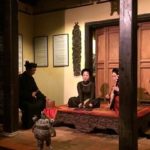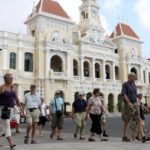The annual Spring Calligraphy Festival and Hieu hoc (Studiousness) Calligraphy Exhibition began on February 3 at the Lake of Literature located within the Temple of Literature in Hanoi.
This year’s festival showcased 40 calligraphers who were selected through a writing competition to exhibit their works.
Adhering to tradition, the calligraphers, decked out in traditional garments, sit in bamboo tents.
Stalls have been set up around the lake to cater to visitors who wish to request calligraphic letters.
| Deputy Director of Hanoi’s Department of Culture and Sports Tran Thi Van Anh (second from right) remarked that the festival plays a crucial role in preserving the traditional cultural heritage of the nation. Photo: Ngo Minh/The Hanoi Times |
The calligraphy exhibition also featured 50 pieces of calligraphy in the forecourt of the Temple of Literature and another 50 around the Literature Lake. These works reflect the thousand-year-old spirit and tradition of learning of the Vietnamese people.
In addition to the festival, there will be various activities such as the Scholar Village, the Handicraft Village, traditional education and examination spaces, and reading culture.
Moreover, the event will showcase traditional handicrafts, souvenirs, and spring culinary culture. Performances of ethnic folk music and dances will also be held to feature traditional cultural practices such as love duets, ceremonial singing, traditional opera, water puppetry, and lion and dragon dances.
During the Spring Calligraphy Festival, Hanoi residents and visitors usually flock to the Temple of Literature, seeking to have meaningful calligraphic words written on red or yellow poonah paper. These words represent their wishes for happiness, longevity, good health, luck, success, and prosperity during the Lunar New Year.
These calligraphic works are then used to adorn people’s homes during the festive season.
Le Xuan Kieu, director of the Van Mieu-Quoc Tu Giam Centre for Cultural and Scientific Activities, stated that the number of tourists visiting the location last year reached two million, many of whom were students eager to learn about the nation’s educational history and tradition.
Alongside the Spring Calligraphy Festival, the Centre also organized other exhibitions during the Lunar New Year, including “Drawing the Dragon,” “Dialogue with Japanese Ukiyo-e Woodblock Prints,” and “Initiating the Source of Study,” all of which have attracted a multitude of visitors.
The Spring Calligraphy Festival will continue until February 19 and opens daily from 8 a.m. to 10 p.m.
| As many as 50 calligraphic works are on display at the Literature Lake. Photo: Ngo Minh/The Hanoi Times |
| The exhibition showcases calligraphic works depicting famous sayings and poems. Photo: Ngo Minh/The Hanoi Times |
| Calligraphers often employ Sinographic and Latin scripts when writing words that convey happiness, longevity, and good health. Photo: Ngo Minh/The Hanoi Times |
| Calligraphy is a popular decoration in people’s homes during the Lunar New Year. Photo: Ngo Minh/The Hanoi Times |
| The word An signifies peace. Photo: Ngo Minh/The Hanoi Times |
| The exhibition features a recreation of the village of scholars. Photo: Ngo Minh/The Hanoi Times |
| The Spring Calligraphy Festival has attracted a large number of visitors. Photo: Ngo Minh/The Hanoi Times |
| Calligraphic works are traditionally written in Sinographic script. Photo: Ngo Minh/The Hanoi Times |
Ancient house in Ma May
NDO – Ma May, a rare quarter that still retains several old houses, has created one of the characteristics of Hanoi. Hanoi’s streets are becoming increasingly crowded and traditional features can sometimes be hidden behind modern life. But if one takes the time to relax and look around, the ancient features begin to reveal themselves.
Russian Film Week opens in Hanoi
NDO – Russian film-lovers in Hanoi will have a chance to enjoy the country’s well-known films with free entrance from December 9 to 13 during the “Russian film week in Hanoi”.

















